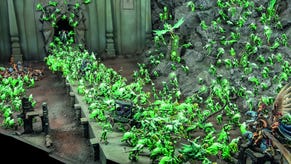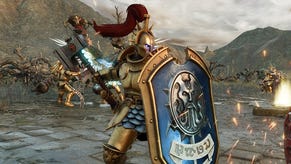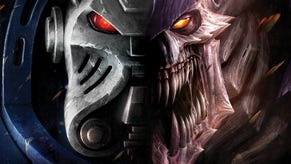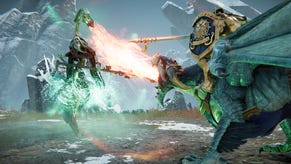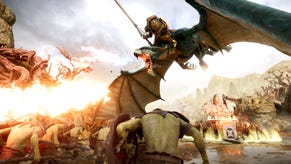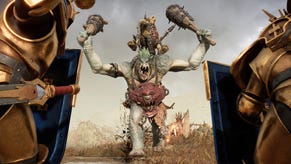The new-look Cities of Sigmar army is a rousing return for what was a hodgepodge of Warhammer Fantasy holdovers
Greater than the sum of its parts.
The Cities of Sigmar have always occupied an odd position in the Age of Sigmar lineup. Supposedly representing the regular folk inhabiting cities in territory won back from Chaos by Sigmar’s elite Stormcast Eternals, the army consisted almost entirely of miniatures from Warhammer Fantasy Battle’s Empire, elf and dwarf ranges that didn’t fit in anywhere else.
The melting-pot aspect was a nice change from the typical Warhammer monoculture, but the army lacked any real identity of its own. As Age of Sigmar’s background was developed across the game itself, novels and licensed products like the superb Soulbound RPG, the Cities of Sigmar army itself felt increasingly disconnected from the cities presented in the lore.
It’s a problem I ran into myself not long before the Cities of Sigmar range refresh was announced. I’d been reading about the mortal inhabitants of Shyish, the realm of death, boning up (pun intended) for the Soulbound campaign I was running, and became enamoured with the city of Lethis. The death god Nagash had achieved supremacy by destroying all the other deities of the realm, but the folk of Lethis still honour Morrda, the Bleak Raven, who they believe is merely in hiding.
Lethis had everything I wanted in an army project. The backstory was interesting (especially the suggestion that Morrda was actually the death god Morr from WFB, having survived the destruction of the Old World) and all the corvid trinkets and such made for some excellent conversion and kitbashing opportunities.
Sadly, my excitement was quickly curtailed when I had a proper look at the existing model range. While I adore the very particular late mediaeval, Holy Roman Empire style of the old WFB Empire minis, they felt too distinct and not at all in line with how the folk of Lethis were described. The amount of work I’d have to do to get even the basic troops looking right would be way too much for an army project. I shelved the idea, but when the CoS refresh was announced, I became cautiously excited, a feeling that only intensified as more and more details were released.

Well, friends, I’m pleased to report that GW has knocked this one out of the park. The Cities of Sigmar launch box is a lovely thing that has exceeded all of my expectations. After being quite critical of some of GW’s recent big boxes, it’s a genuine pleasure to get my hands on one that I only have nice things to say about.
The Cities of Sigmar launch box is a lovely thing that has exceeded all of my expectations.
Crack open the box and, buried beneath all the grey plastic, you’ll find the customary limited edition version of the faction’s battletome. Festooned with the emblems of the cities and with some classy gold edging to complement the deep reds, it’s just a very attractive book. The artwork is of the typically high standards found in GW products, but the care that has gone into portraying the massive cities themselves, the battle-weary soldiery and all the little details like the heraldry of each city really elevates the book.
The content is divided up as you’d expect, with a minis gallery and hobby sections sandwiched between the background at the front and rules at the back. I found the hobby section to be very good, covering techniques for materials commonly found across the miniature range and providing paint recipes suitable for each of the cities. The leather and cloth recipes are particularly useful tools to have, and I’ve already used some on other miniatures. As well as the battletome, you get a thick sheet of punch-out card tokens and two decks of cards: a larger set of warscroll cards and regular playing card-sized enhancement cards.

In terms of miniatures, you get three units and two characters. First up are two units of ten Freeguild Steelhelms, the rank-and-file of the new-look Cities of Sigmar army. These are definitely a contender for my favourite miniatures of the year. They’re a breeze to build and have loads of options, while also being genuinely diverse. A wide range of genders, body types and ethnicities are clearly on display in the sculpting and reflected in the paint jobs shown in the book. Assembling the minis, I got a sense of a group of real people with individual personalities coming together to defend their homes. There’s an almost Discworld vibe; you can absolutely see them as members of the Ankh-Morpork City Watch.
They’re supported by five mounted Freeguild Cavaliers, veteran soldiers deployed as heavy cavalry. They’re not knights or nobles, just accomplished warriors who have earned or assembled better gear and a mighty steed. Like the Steelhelms, the kit balances interesting posing - often lacking on cavalry - with customisability, giving you a lot of options. While not overly difficult to build, they are complex; putting them together will take a good few hours. They’re also packed with detail; while the Steelhelms are deceptively simple to paint, expect to take some time even just getting base coats down on them.
The Freeguild Steelhelms are definitely a contender for my favourite miniatures of the year.
Leading these troops is a Freeguild Marshal, a foot commander accompanied by a Relic Envoy. Even though it’s for a single character with his chum, there are options for this kit, allowing for some customisation. Arms and weapons are available for doing all the equipment loadouts in the rules, plus a few more if you’re willing to go off-book - including dual-wielding massive shields, for the Dark Souls fans. There are three different heads and, while none of them are helmeted, he can carry one tucked under one arm. The Relic Envoy is less fortunate, having no build options whatsoever, but he’s still a nice model consisting of just three parts.
Also lacking in options is the last model of the set, the Alchemite Warforger. This buff, blacksmith battle-wizard is a visual departure from the rest of the included minis as he’s not a member of the Freeguilds. He still ties in very nicely with the rest of the range, especially once you’ve got him painted up appropriately. In terms of painting, he was probably my favourite of the lot, with lots of beautifully sculpted textured leather and metal.
None of this would have mattered if the actual contents of the battletome weren’t any good. Yet, as with the models, Games Workshop has really delivered. The new range is a bit of an unusual beast because it’s neither an entirely new army, nor is it simply an update of existing miniatures.
Most of the old human units are gone, with a few holdouts like the steam tank and flagellants, while the aelves and duardin (the fancy, more trademarkable names for elves and dwarves in Age of Sigmar) have been cut back, but still have a solid core of an army from the existing range. This shift is explained by the lore, which states that the old human units represented Azyrites: people who had been safely holed up with Sigmar during the Age of Chaos and had come to help retake the Mortal Realms from Chaos once the Stormcast Eternals had established a beachhead.
Assembling the minis, I got a sense of a group of real people with individual personalities coming together to defend their homes. There’s an almost Discworld vibe.
The new units are mostly made up of Reclaimed, the folks whose ancestors managed to weather the Age of Chaos and were found after the Age of Sigmar began. Now they’re no longer battling for survival on a daily basis, they’re keen to get out there and take back their ancestral homelands from the forces of Chaos, Death and Destruction. They’ve also developed new tactics in the form of the Castellite Doctrine, a mobile fortress with the pavise (fancy word for big, free-standing shield) and firearm-equipped Freeguild Fusiliers functioning as the walls, and the Fusil-Majors and Ironweld Great Cannons acting as the towers and gates, respectively. This is all backed up by the army special rule, a system of orders that are handed out to your hero models so that they can bellow them at the troops. Combined with unit rules, the focus on buffing and supporting each other, rather than raw power, elegantly conveys the impression of normal people working together to defeat fantastic threats.
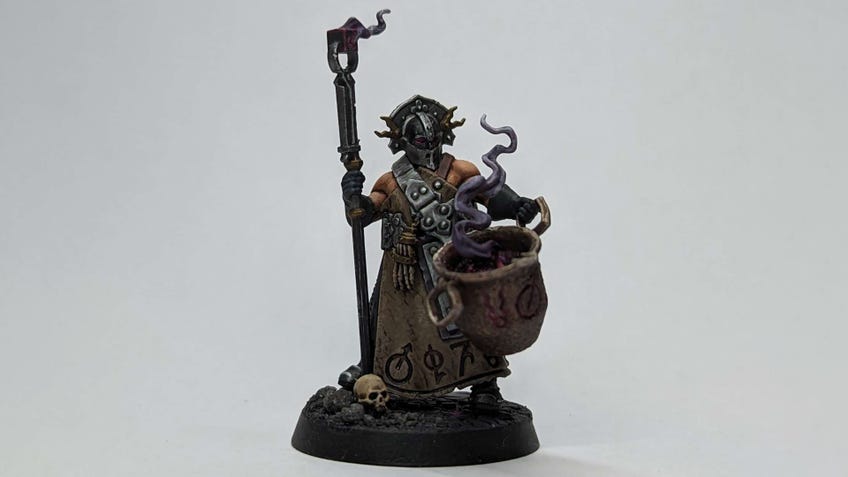
There are 11 cities featured in the book, at least one for each realm. They all have background, iconography, colour schemes and a unique special rule. Fans of cities that traditionally ally with other factions, like the Living City allying with Sylvaneth, will be pleased to know that their rules take this into account and are designed to work with units from both factions. (I was delighted to discover that my beloved Lethis is included and its special rule allows you to field your heroes as Raven Priests.
The narrative-focused Path to Glory section is also worth calling out, as it’s often seen as being a bit bland compared to its 40k counterpart, Crusade. The rules allow you to field your own Dawnbringer Crusade, marching out from your chosen city to reclaim the realms. Instead of starting with territory and slowly expanding it, your army will complete quests as you play, eventually accumulating enough points to attempt to claim a site for a new city. This comes with a special scenario where your forces have to protect their new home from wave after wave of enemies, which looks like an absolute blast to play. Afterwards, you establish your new city which continues to grow in a more typical fashion.
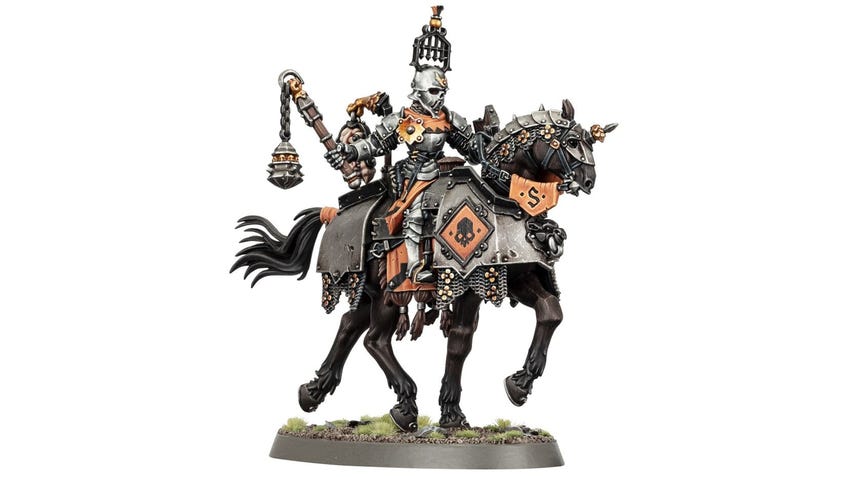
There is a downside to this. My only real criticism is that the human, aelf and duardin parts of the cities feel even more separate than before. While there are a couple of universal orders, for the most part orders and character enhancements are locked to one of the three cultures, and special rules on units generally only work on other units of the same species. While there’s nothing stopping you, as an example, adding a unit of duardin Ironbreakers to the units you get in this box, they won’t benefit from any of the buffs the Marshal and Warforger can dish out.
While I understand and appreciate the focus on humans with this release - as outside of Chaos worshippers they had no real representation in Age of Sigmar - it is a shame that they’re not more integrated. It gives the distinct impression that this wave of releases is something of a stopgap, and that in the future the aelves and duardin will either be replaced or discarded altogether. It’s also going to hit many existing Cities of Sigmar players pretty hard. While I imagine armies won’t necessarily be invalidated by the changes, especially with a little proxying, they certainly won’t function as effectively as those based around the new range of human miniatures.
While I understand and appreciate the focus on humans, it is a shame that they’re not more integrated.
That said, the cities have always been home to some really creative players who have made wonderful armies out of the existing range. While I’m focusing on the new miniatures, I’m still slipping in some converted aelves and duardin into their ranks, as I’m keen to keep that melting-pot vibe.
Aside from that one issue, I have no complaints about the Cities of Sigmar launch box. Like the humble folk of the cities pulling together to defend the Mortal Realms, the battletome and miniatures work together to conjure a unique identity into the faction that manages to be grounded and relatable, while also feeling in line with the high-fantasy stylings of Age of Sigmar.




